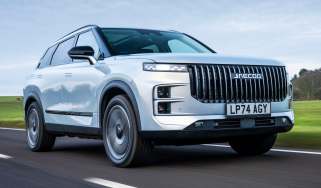Toyota RAV4 (Mk1, 1994-2000) icon review
We take a look back at the Mk1 Toyota RAV4 - arguably where the ‘soft-roader’ trend all started
SUVs now account for more than half of all new-car registrations in Europe. That should hardly come as a shock – simply look out your window, and you can be fairly sure the next vehicle to drive past has a bit of extra ride height going on, and quite possibly some plastic cladding around the wheelarches.
As for how this has happened, you might point the finger at the Qashqai – a car that blew away even Nissan’s own sales projections, spawned countless imitators and put us on track for the SUV-filled roads of today. But while the Qashqai undoubtedly popularised the idea of a ‘soft-roader’, such cars had already been kicking around for some time. And the first of them was the Toyota RAV4.
To understand what the RAV did so differently, you merely have to look at the options of the time if you did want a high-riding vehicle. It often meant buying a ‘proper’ 4x4 with body-on-frame construction – a Land Rover Discovery, perhaps, or maybe a Nissan Patrol. Big, heavy cars such as these were expensive to purchase and run, and while being great off road, they weren’t that brilliant on it.
Used - available now
Shaking up proceedings significantly in 1994 was Toyota with its RAV4, or “Recreational Active Vehicle with four-wheel drive”. It was built not around an old-fashioned ladder chassis, but a new monocoque structure derived from that of the Corolla and Carina family cars. The travel of the fully independent suspension was deliberately made much shorter, but longer than the average hatchback’s.
Ground clearance was made to be generous but not excessive, and there was a permanent four-wheel-drive system and a locking differential, despite a lack of low-range transmission. The focus for the RAV4 was very much the road, but its maker always had one eye on the off piste, just in case any customers wanted to tackle slightly rougher routes.
The car was kept very compact, too, especially in three-door form. All of these factors came together to make a model that was seriously light, weighing in at less than 1,200kg. A contemporary Vauxhall Frontera, for context, was more like 1,600kg.
A low weight figure meant the RAV4 sported a simple, modestly powered petrol engine – the tried-and-tested 3S-FE – which gave a good blend of performance and economy. There was even an electric version, which was sold in small quantities in California in order to comply with the state’s zero-emissions vehicle rules. This combined a front-mounted 67bhp motor and a 27kWh battery pack for a range of nearly 100 miles.
In the metal, the 1995 three-door example from Toyota’s UK heritage fleet looks fabulous. Compact and chunky at the same time, there’s a real sense of fun to it, with unpainted lower bodywork giving a two-tone effect, and a fat B-pillar standing out brilliantly against the rear glasshouse. The RAV4 would feel right at home parked up next to a sandy beach somewhere sunny, and would easily brighten up even a less interesting setting.
Inside, the cabin is somewhat less cheery. We can’t single the RAV4 out for this, though – nineties car interiors aren’t exactly known for their flair. In here, it’s the usual abundance of straight lines and grey ‘rhino’s bum’-effect cladding for the dashboard.
At least this version has some jazzy patterns on the seat upholstery, as well as a few neat touches, including a coin holder and a flat-topped section of the dashboard in front of the passenger, which incorporates a couple of handy storage areas and a cup-holder.
Further back, the tailgate opens in a less-than-practical side-hinged manner to reveal a comically small boot. Those in need of more space had to wait until 1996, when the five-door RAV4 joined the range. The spec is basic, with manual-winding windows and a lack of air-conditioning, but the car does have central locking.
On the move, the RAV4’s lack of bulk is soon apparent. The 2.0-litre, 16-valve inline-four engine gets the pint-sized SUV up to speed eagerly, clocking an 8.8-second 0-62mph time. That’s not far off a lot of supposed performance cars of the era. You could combine this powerplant, or the four-cylinder diesel, with a four-speed automatic transmission, although this RAV4 has the five-speed manual. It features a long throw, but the shift itself feels accurate and satisfying.
The engine needs to be worked hard to make decent progress, and it sounds quite gruff when doing so. Even when the RAV4 was new, this was a fairly old unit. It also sits at a fairly lofty 3,500rpm at a 70mph cruise, which, combined with some pretty basic soundproofing, makes long journeys quite noisy and tiring. The ride is jittery as well, never really settling, but the suspension soaks up large surface imperfections adeptly.
Perhaps unexpectedly, country lanes are where the RAV4 feels most at home. Yes, compared with a modern compact SUV the steering is very slow, but there’s no excessive slack in the centre – and while the Toyota does lean quite a bit in corners, it feels tidy enough and very willing to change direction owing to its light weight. You just need to bear in mind the car’s limitations, because barrelling into a bend with too much gusto will reveal its keenness to understeer.
Although clearly now showing its age, the first-generation RAV4 is a fun, life-affirming little thing to drive around in. It certainly won over plenty of buyers back in the day – something that didn’t go unnoticed by rivals, which soon tried to get a slice of the pie with cars such as the Land Rover Freelander.
The Toyota’s success laid the groundwork for these compact SUV-obsessed times we now find ourselves in, and the name’s popularity continues today. More than a million RAV4s were sold globally last year, making it 2022’s most popular car. But does the fourth-generation model still have the charm of the original? With three-door versions long since gone (they died off when the second-gen car was discontinued) and the cutesy, Tonka-toy-like aesthetic notably absent, we’d have to say no.
What we said then
- Issue 300, Summer 1994
“Does the RAV4 provide a compromise? It’s not a true off-roader, but it’s capable of getting you out of the mire. It has the advantages of small 4x4s like the Suzuki Vitara, but is more akin to a car in ride and handling. Having taken an eight-year back seat in this booming market, Toyota could now be ahead of the game.”
Interested in buying one
The RAV4 Mk1 is something of an underappreciated modern classic. Of the cars we’ve featured in our Icon Drives series thus far, it’s probably the one you can buy for the least money – tatty examples start at less than £1,000, and £2,000 upwards should bag you something very tidy.
From what we’ve seen, three-door RAV4s are more abundant on the used market, which we’d attribute to this model being more desirable and thus deemed more worth preserving by owners. You won’t have masses of choice, though, so you might want to also consider a Mk2, which didn’t depart from the original recipe as much as later RAV4s.
You can buy with confidence, knowing these are well built and generally reliable cars that don’t suffer too badly from rust. Regardless, you should keep an eye out for corrosion, particularly on the sills and suspension mounts, and ensure the petrol engine’s cambelt has been changed on schedule at 60,000 miles.
| Model: | Toyota RAV4 Mk1 |
| Production dates: | 1994-2000 |
| Price then: | From £12,500 |
| Price now: | From £2,000 |
| Engine: | 2.0-litre 4cyl petrol, 128bhp |
| 0-62mph: | 8.8 seconds |
| Top speed: | 106mph |










